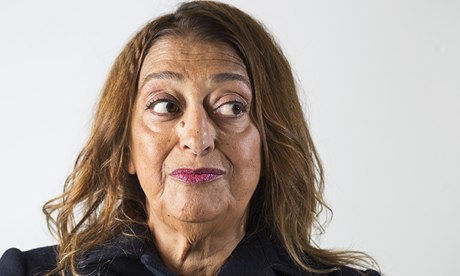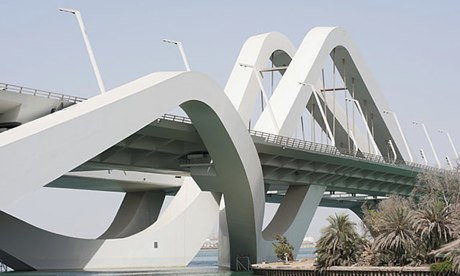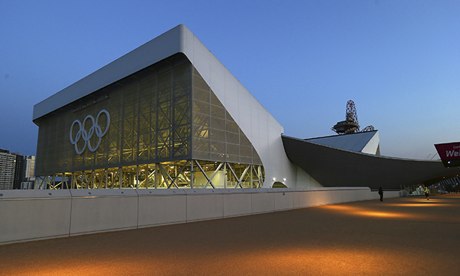Submitted by WA Contents
Zaha Hadid: ’I don’t make nice little buildings’
United Kingdom Architecture News - Sep 24, 2013 - 21:41 7849 views
Her fans consider her a bloody-minded genius, her detractors a 'starchitect' of convoluted fantasies. As the Serpentine Sackler gallery opens in London, she talks about resisting rectangular design – and why she'd be happy to build in Syria

Zaha Hadid: 'The world is not a rectangle.' Photograph: David Levene for the Guardian
The Zaha Hadid gallery contains a metropolis in miniature, a streetplan of fantastical scale models preserved under perspex. Hadid's PR walks me down the aisles and points out the landmarks. Over here is the imposing MAXXI museum in Rome and over there the BMW plant in Leipzig, where translucent conveyor belts ferry the cars between the factory floors. Away in the corner, the gallery floorspace is occupied by what appears to be a white, frozen avalanche of futurist geometry. This, I am told, is the design for a building in Saudi Arabia.
I stare at the avalanche with mounting alarm. I'm looking for the windows, I'm looking for the door. Try as I might, I can't see it as a building. "No, of course," the PR says. "It's a concept."
Increasingly, it seems, Zaha Hadid's concepts are becoming constructions. At the age of 62, she has blossomed into one of the world's most celebrated and sought-after architects, with a staff of 350, aPritzker prize on the shelf and around 40 buildings already dotting the globe. Her practice is putting the finishing touches to Japan's national stadium, the principal venue for the 2020 Olympics. Her undulatingSerpentine Sackler gallery, nestled in the heart of Hyde Park, opens for business this week. For fans of her work, Hadid is a bloody-minded genius, the woman who broke the mould, upturned the applecart and found fluid solutions to rectangular problems. For her detractors, however, she's something else again: a showboating "starchitect" who trades in hubristic, convoluted fantasies. Many of her concepts, it's claimed, would have been better off as drafts.

The Serpentine Sackler gallery. Photograph: Karen Robinson
Hadid arrives late and dramatically, like a stage tragedian at the end of act one. Her hair is windblown, her black coat is flapping and her piercing gaze finds a problem in every nook and cranny. The gallery staff scurry in her wake, toiling to make her comfortable. But it's no use: the room is too cold and the TV won't work. She explains that she has only just had the screen installed. It's a smart TV, so it's meant to do everything ("you can get Netflix on it"), except that right at this moment it's doing nothing at all. "Another failed project," she says, and gives a grin that could pass for a grimace.
Hadid was born in Iraq into a wealthy, liberal family, though she has lived in London for 40 years and now considers it home. And yet the capital, playing it cool, has at times been slow to return the embrace. In recent years she has worked on the Sackler, an academy in Brixton, and the extraordinary Aquatics centre in the Olympic park. Even so, she feels the city remains too corporate and too conservative a canvas. First, it's in thrall to a starchy old boys' network that she has never been a part of. Second, its shackled to historicism, constantly looking to the past. What London does best, she feels, is generate ideas. That's what it was like when she first arrived to study architecture in the 70s – everybody trying to forecast the future and raise new utopias. And the future, of course, is a hard act to sell. "When people see something fantastic they think that it's not possible to achieve it in real life," she says. "But that's not true. You can achieve amazing things."
Her gaze skips away; she's been distracted again. On this occasion the culprit appears to be the PR. He is standing to one side, idly checking his texts. "Roger, please, can I have your phone?" she says. "I just cannot look at you on your phone. Give it to me, I beg you." She confiscates the phone, pops it in her bag and then tugs at her coat. "It's either boiling or freezing in here," she mutters, as though the two devices – the phone and the thermostat – may somehow be connected.
I think a lot of her work is astonishing. I love the MAXXI museum, with its overlapping walkways and entwined concrete limbs. I also like the spooky streamlining of her Salerno ferry terminal and the lush, liquid whip of theHeydar Aliyev centre in Azerbaijan. Hadid's best buildings are sensual and intoxicating; a kind of new flesh for the new century. Frank Gehry describes the architect as "an extraordinary force of nature", while designer Donna Karan heaps praise on her "female sensibility" and "goddess's touch". Yet still the doubts remain. Hadid's designs are so swishy, so brazen, so shamelessly flamboyant that they surely run the risk of putting experimentation ahead of functionality. I worry that her boldest projects become a kind of abstract art. These are things that we might relish in a gallery but baulk at hanging in the sitting room, never mind attempting to live and work inside.
"Well, it's not normal practice," she concedes. "We don't deal with normative ideas and we don't make nice little buildings. People think that the most appropriate building is a rectangle, because that's typically the best way of using space. But is that to say that landscape is a waste of space? The world is not a rectangle. You don't go into a park and say: 'My God, we don't have any corners.'" She insists that all of her buildings are entirely practical; they are just constructed around different organisational patterns. "It's like saying that everyone has to write in exactly the same way. And it is simply not the case."

Hadid-designed Sheikh Zayed bridge in Abu Dhabi. Photograph: Alamy
Hadid's first successful commission, back in 1994, was to design a fire station for the Vitra furniture factory in Germany. On an aesthetic level, this was judged to be a triumph. However, it was later decided that the fire station did not quite work as a fire station and the building has since been made over as a museum for chairs. Doesn't that make the building a failure?
"No," says Hadid. "Because it was always intended as a multi-functional building. It was not done as a fire station for the whole city, it was only for the factory. And then the city upgraded its fire station, so the factory used that. But it was always thought that it could be used for training purposes, or as an event space." She pulls a face. "They sometimes use it to exhibit chairs, it's true. I had dinner there quite recently."
Other commissions have brought knottier problems. Despite being shunned by the boys' club, Hadid has found ardent support in central Asia and China, where the regulations are looser and the patrons more dubious. Just last month the Beijing Cultural Heritage Protection Centre wrote an open letter protesting about the colossal Galaxy Soho office and leisure complex that recently went up in the heart of the city. The scheme, they said, rode roughshod over the traditional Hutong neighbourhoods and was an "unfortunate example of the destruction of Beijing old town".
Or take the case of the Heydar Aliyev cultural centre in Baku, raised in honour of Azerbaijan's former president and commissioned by his son, the current incumbent. Basking on the landscape like some space-age leviathan, the centre nonetheless stands as an implicit salute to a nation beset by human rights abuses and allegations of corruption, torture and stuffed ballot boxes. Reports suggest that Baku's bold programme of urban renewal has been furnished by forced evictions, with an estimated 60,000 inhabitants driven from their homes since 2008.
"Well, I mean, I'm not a politician," Hadid tells me. "I'm not an agitprop artist. Of course it's difficult. But, irrespective of the regime, it's important to build a civic facility for the population. If someone asks me to do a library, I wouldn't say I don't want to do it because of where it is. It's important to engage with these countries because it connects them to the rest of the world." She shakes her head. "If I say I'm not going to build in certain places, there are lots of other places I wouldn't go to either. I wouldn't be doing anything anywhere. I just wouldn't build."
For the sake of argument, let's say that Bashar al-Assad is on the phone. He wants her to build him a prison in Damascus. "Well, I wouldn't mind building in Syria," she shrugs. "I'm an Arab and if it helps people, if it's an opera house or a parliament building, something for the masses, I would do it. But if someone asks me to build a prison, I wouldn't do it. I wouldn't build a prison, irrespective of where it is, even if it was very luxurious."

The aquatics centre at the Olympic Park, London. Photograph: Clive Rose
Luxurious? I think it's safe to assume it wouldn't be. But Hadid just already jumped topic, beating back to Azerbaijan. Baku, she tells me, is a fascinating place, an intersection of worlds, a jumble of Soviet, Turkish and Persian influences. "I felt very strongly that, as an Arab, there should be some of my work there."
She dates her love of architecture back to a childhood visit to the ancient Sumerian cities in the south of Iraq. Her inspiration, she says, are "the rivers and the dunes", the fluid landscape of the Middle East. But now Iraq is in ruins and her homeland is a memory. Last year she accepted a commission to design the new central bank beside the Tigris in Baghdad. This will involve her first voyage back after more than 30 years away.
Hadid is looking forward to the trip, although she is also nervous of what she might find. She recalls a recent visit to Beirut, which she had loved in her youth. The whole place was altered, bombed to bits and the souks and bazaars had all gone. "If you come to London, you think of Trafalgar square and then navigate the city from there," she says. "But if Trafalgar Square has disappeared, then you're lost, you can't get your bearings, and Beirut was like that. It was very weird for me." The buildings, it transpires, do not always outlive us.
Hadid isn't married and doesn't have children. She lives alone in what visitors have described as a stark and impersonal flat down the road from her office. No doubt it works for her, though it sounds a little bleak. I ask when she's going to design a house of her own and what it might look like, if money were no object and she could let her imagination run wild. Hadid responds with a harried smile and says that she's too busy, there's never the time, and who builds a house in central London anyway? She sits at the table, her coat pulled tight against the air-con; a workaholic who builds for others and yet never for herself. On balance, she says, she would rather make an office building because that would be more practical. "I'm hardly ever at my house," she says. "I'm hardly ever at my home."
The Serpentine Sackler gallery opens to the public on 28 September.
> via TheGuardian
